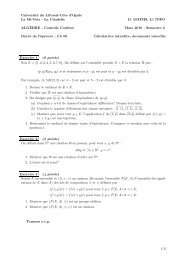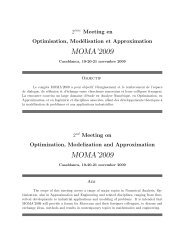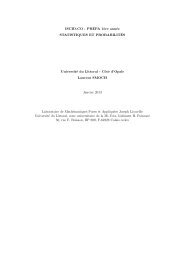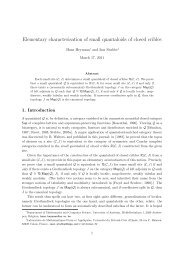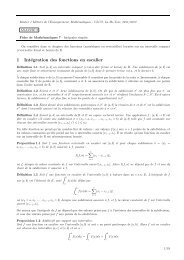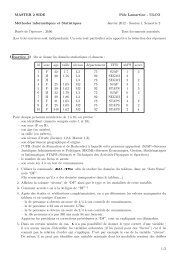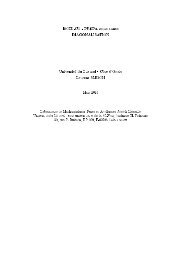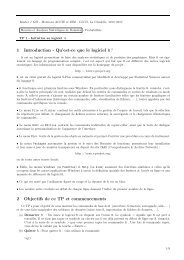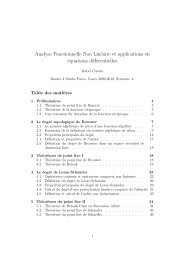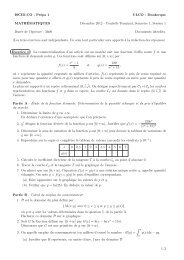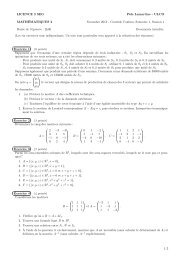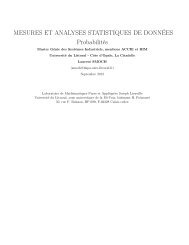HEI : Analyse Numérique Chapitre 1 : Interpolation H. Sadok - L.m.p.a
HEI : Analyse Numérique Chapitre 1 : Interpolation H. Sadok - L.m.p.a
HEI : Analyse Numérique Chapitre 1 : Interpolation H. Sadok - L.m.p.a
You also want an ePaper? Increase the reach of your titles
YUMPU automatically turns print PDFs into web optimized ePapers that Google loves.
.<br />
<strong>Interpolation</strong> Polynomiale<br />
Construction du polynôme d’interpolation<br />
Polynôme d’interpolation et base de Newton<br />
comparaison<br />
Erreur d interpolation<br />
Programmation<br />
<strong>HEI</strong> : <strong>Analyse</strong> <strong>Numérique</strong><br />
<strong>Chapitre</strong> 1 : <strong>Interpolation</strong><br />
H. <strong>Sadok</strong><br />
. .<br />
.<br />
2011-2012<br />
. . . . . .<br />
<strong>Sadok</strong> Hassane, Site web : www-lmpa.univ-littoral.fr/∼sadok Cours d’<strong>Analyse</strong> <strong>Numérique</strong>, <strong>Chapitre</strong> 1 : <strong>Interpolation</strong><br />
.<br />
.
<strong>Interpolation</strong> Polynomiale<br />
Construction du polynôme d’interpolation<br />
Polynôme d’interpolation et base de Newton<br />
comparaison<br />
Erreur d interpolation<br />
Programmation<br />
. Plan<br />
.<br />
. .1 <strong>Interpolation</strong> Polynomiale<br />
Position du Problème<br />
Existence<br />
Unicité<br />
.<br />
. .2 Construction du polynôme d’interpolation<br />
polynômes de Lagrange<br />
Formule Barycentrique<br />
.<br />
. .3 Polynôme d’interpolation et base de Newton<br />
definition<br />
Différences Divisées<br />
Exemple <strong>Numérique</strong><br />
.<br />
. .4 .<br />
.<br />
comparaison<br />
.5 .<br />
.<br />
Erreur d interpolation<br />
.6 Programmation<br />
<strong>Sadok</strong> Hassane, Site web : www-lmpa.univ-littoral.fr/∼sadok Cours d’<strong>Analyse</strong> <strong>Numérique</strong>, <strong>Chapitre</strong> 1 : <strong>Interpolation</strong><br />
. . . . . .
. Bibliographie<br />
<strong>Interpolation</strong> Polynomiale<br />
Construction du polynôme d’interpolation<br />
Polynôme d’interpolation et base de Newton<br />
comparaison<br />
Erreur d interpolation<br />
Programmation<br />
Position du Problème<br />
Existence<br />
Unicité<br />
A. Quarteroni, F. Saleri et P. Gervasio, Calcul Scientifique ,<br />
Springer-Verlag France, Paris, 2010.<br />
S. Guerre-Delabrière et M. Postel, «Méthodes<br />
d’approximation, Equations différentielles, Applications<br />
Scilab», Ellipses, Paris, 2004.<br />
M. Crouzeix et A. L. Mignot, « <strong>Analyse</strong> <strong>Numérique</strong> des<br />
Equations Différentielles », Masson, Paris, 1983.<br />
. . . . . .<br />
<strong>Sadok</strong> Hassane, Site web : www-lmpa.univ-littoral.fr/∼sadok Cours d’<strong>Analyse</strong> <strong>Numérique</strong>, <strong>Chapitre</strong> 1 : <strong>Interpolation</strong>
. Position du Problème<br />
<strong>Interpolation</strong> Polynomiale<br />
Construction du polynôme d’interpolation<br />
Polynôme d’interpolation et base de Newton<br />
comparaison<br />
Erreur d interpolation<br />
Programmation<br />
Position du Problème<br />
Existence<br />
Unicité<br />
On se donne le tableau de données suivant<br />
i xi yi<br />
0 x0 y0<br />
.<br />
.<br />
.<br />
n xn yn<br />
.<br />
Définition<br />
. .<br />
On cherche un polyôme Pn de degré au plus n (Pn ∈ Pn )tel<br />
que<br />
Pn(xi) = yi, pour i = 0, . . . , n.<br />
. .<br />
.<br />
. . . . . .<br />
<strong>Sadok</strong> Hassane, Site web : www-lmpa.univ-littoral.fr/∼sadok Cours d’<strong>Analyse</strong> <strong>Numérique</strong>, <strong>Chapitre</strong> 1 : <strong>Interpolation</strong><br />
.<br />
.
. Existence<br />
<strong>Interpolation</strong> Polynomiale<br />
Construction du polynôme d’interpolation<br />
Polynôme d’interpolation et base de Newton<br />
comparaison<br />
Erreur d interpolation<br />
Programmation<br />
Soit Pn ∈ Pn alors<br />
Position du Problème<br />
Existence<br />
Unicité<br />
Pn(t) = a0 + a1t + . . . + ant n<br />
et donc Pn(xi) = yi, pour i = 0, . . . , n si et seulement si<br />
⎧<br />
a0 ⎪⎨<br />
+ a1x0 + . . . . . . . . . . . . . . . + anx<br />
⎪⎩<br />
n 0 = y0<br />
a0 + a1x1 + . . . . . . . . . . . . . . . + anx n 1 = y1<br />
. . . . . . . . . . . . . . . . . . . . . . . . . . . . . . . . . . . . . . .<br />
a0 + a1xn + . . . . . . . . . . . . . . . + anx n n = yn<br />
On obtient un système d’équations linéaires dont le vecteur<br />
inconnu est (a0, . . . , an).<br />
. . . . . .<br />
<strong>Sadok</strong> Hassane, Site web : www-lmpa.univ-littoral.fr/∼sadok Cours d’<strong>Analyse</strong> <strong>Numérique</strong>, <strong>Chapitre</strong> 1 : <strong>Interpolation</strong>
. Résolution du système linéaire<br />
<strong>Interpolation</strong> Polynomiale<br />
Construction du polynôme d’interpolation<br />
Polynôme d’interpolation et base de Newton<br />
comparaison<br />
Erreur d interpolation<br />
Programmation<br />
Position du Problème<br />
Existence<br />
Unicité<br />
Le système précédent s’écrit sous forme matricielle sous la<br />
forme :<br />
⎛<br />
1<br />
⎜<br />
⎝<br />
x0 . . . x n 1 x1 . . .<br />
0<br />
x n . . . . .<br />
1<br />
.<br />
1 xn . . . x n ⎞ ⎛<br />
a0<br />
⎟ ⎜<br />
⎟ ⎜ a1<br />
⎟ ⎜<br />
⎠ ⎝ .<br />
⎞<br />
⎟<br />
⎠<br />
n an<br />
=<br />
⎛<br />
y0<br />
⎜ y1<br />
⎜<br />
⎝ .<br />
⎞<br />
⎟<br />
⎠<br />
yn<br />
On obtient un système d’équations linéaires dont la matrice est<br />
la matrice de Vandermonde et dont le vecteur inconnu est<br />
(a0, . . . , an).<br />
⎛<br />
⎜<br />
Pn(t) = (a0, a1, . . . , an) ⎜<br />
⎝<br />
1<br />
t<br />
.<br />
. . . . . .<br />
tn <strong>Sadok</strong> Hassane, Site web : www-lmpa.univ-littoral.fr/∼sadok Cours d’<strong>Analyse</strong> <strong>Numérique</strong>, <strong>Chapitre</strong> 1 : <strong>Interpolation</strong><br />
⎞<br />
⎟<br />
⎠
. Thérème d’existence<br />
<strong>Interpolation</strong> Polynomiale<br />
Construction du polynôme d’interpolation<br />
Polynôme d’interpolation et base de Newton<br />
comparaison<br />
Erreur d interpolation<br />
Programmation<br />
Position du Problème<br />
Existence<br />
Unicité<br />
.<br />
Déterminant de Vandermonde<br />
. .<br />
Le déterminant de Vandermonde vérifie :<br />
.<br />
<br />
<br />
1 x0 . . . x<br />
<br />
<br />
det(Vn+1(x0, · · · , xn)) = <br />
<br />
<br />
<br />
. .<br />
.<br />
n 0<br />
1 x1 . . . x n 1<br />
.<br />
. . .. .<br />
1 xn . . . x n <br />
<br />
<br />
<br />
<br />
=<br />
<br />
<br />
<br />
n<br />
∏<br />
(xj − xi).<br />
0≤i
. Preuve de l’unicité<br />
<strong>Interpolation</strong> Polynomiale<br />
Construction du polynôme d’interpolation<br />
Polynôme d’interpolation et base de Newton<br />
comparaison<br />
Erreur d interpolation<br />
Programmation<br />
Position du Problème<br />
Existence<br />
Unicité<br />
On suppose que Pn(xi) = Qn(xi) = yi, pour i = 0, . . . , n,<br />
Pn − Qn ∈ Pn,<br />
(Pn − Qn)(xi) = 0, pour i = 0, . . . , n,<br />
Pn − Qn est un polynme de degré au plus n qui admet<br />
n + 1 racines.<br />
conclusion : Pn ≡ Qn.<br />
. . . . . .<br />
<strong>Sadok</strong> Hassane, Site web : www-lmpa.univ-littoral.fr/∼sadok Cours d’<strong>Analyse</strong> <strong>Numérique</strong>, <strong>Chapitre</strong> 1 : <strong>Interpolation</strong>
. définition des polynômes de Lagrange<br />
<strong>Interpolation</strong> Polynomiale<br />
Construction du polynôme d’interpolation<br />
Polynôme d’interpolation et base de Newton<br />
comparaison<br />
Erreur d interpolation<br />
Programmation<br />
polynômes de Lagrange<br />
Formule Barycentrique<br />
Nous avons obtenu :<br />
avec<br />
⎛<br />
⎜<br />
⎝<br />
a0<br />
a1<br />
.<br />
an<br />
⎛<br />
⎜<br />
Pn(t) = (a0, a1, . . . , an) ⎜<br />
⎝<br />
1<br />
t<br />
.<br />
t n<br />
⎞<br />
⎟<br />
⎠<br />
⎞<br />
⎟<br />
⎠ =<br />
⎛<br />
1<br />
⎜<br />
⎝<br />
x0 . . . x n 1 x1 . . .<br />
0<br />
x n . . . . .<br />
1<br />
.<br />
1 xn . . . x n ⎞−1<br />
⎛<br />
⎟ ⎜<br />
⎟ ⎜<br />
⎟ ⎜<br />
⎠ ⎝<br />
n<br />
y0<br />
y1<br />
.<br />
yn<br />
⎞<br />
⎟<br />
⎠<br />
. . . . . .<br />
<strong>Sadok</strong> Hassane, Site web : www-lmpa.univ-littoral.fr/∼sadok Cours d’<strong>Analyse</strong> <strong>Numérique</strong>, <strong>Chapitre</strong> 1 : <strong>Interpolation</strong>
. définition des polynômes de Lagrange (suite)<br />
<strong>Interpolation</strong> Polynomiale<br />
Construction du polynôme d’interpolation<br />
Polynôme d’interpolation et base de Newton<br />
comparaison<br />
Erreur d interpolation<br />
Programmation<br />
polynômes de Lagrange<br />
Formule Barycentrique<br />
En transposant la dernière équation on obtient<br />
⎛<br />
⎜<br />
(a0, a1, . . . , an) = (y0, y1, . . . , yn) ⎜<br />
⎝<br />
1<br />
x0<br />
.<br />
1<br />
x1<br />
.<br />
. . .<br />
. . .<br />
. . .<br />
1<br />
xn<br />
.<br />
x n 0 x n 1 . . . x n ⎞<br />
⎟<br />
⎠<br />
n<br />
Et donc<br />
⎛<br />
⎜<br />
Pn(t) = (y0, y1, . . . , yn) ⎜<br />
⎝<br />
1<br />
x0<br />
.<br />
1<br />
x1<br />
.<br />
. . .<br />
. . .<br />
. . .<br />
1<br />
xn<br />
.<br />
x n 0 x n 1 . . . x n ⎞−1<br />
⎛<br />
⎟ ⎜<br />
⎟ ⎜<br />
⎟ ⎜<br />
⎠ ⎝<br />
n<br />
1<br />
t<br />
.<br />
t n<br />
−1<br />
⎞<br />
⎟<br />
⎠<br />
. . . . . .<br />
<strong>Sadok</strong> Hassane, Site web : www-lmpa.univ-littoral.fr/∼sadok Cours d’<strong>Analyse</strong> <strong>Numérique</strong>, <strong>Chapitre</strong> 1 : <strong>Interpolation</strong>
. Construction des polynômes de Lagrange (suite)<br />
<strong>Interpolation</strong> Polynomiale<br />
Construction du polynôme d’interpolation<br />
Polynôme d’interpolation et base de Newton<br />
comparaison<br />
Erreur d interpolation<br />
Programmation<br />
polynômes de Lagrange<br />
Formule Barycentrique<br />
Le polynôme d’interpolation peut donc s’écrire :<br />
⎛ ⎞<br />
L0(t)<br />
⎜ L1(t) ⎟<br />
Pn(t) = (y0, y1, . . . , yn) ⎜ ⎟<br />
⎝ . ⎠<br />
Ln(t)<br />
avec ⎛<br />
⎜<br />
⎝<br />
1<br />
x0<br />
.<br />
1<br />
x1<br />
.<br />
. . .<br />
. . .<br />
. . .<br />
1<br />
xn<br />
.<br />
x n 0 x n 1 . . . x n ⎞ ⎛<br />
⎟ ⎜<br />
⎟ ⎜<br />
⎟ ⎜<br />
⎠ ⎝<br />
n<br />
L0(t)<br />
L1(t)<br />
.<br />
Ln(t)<br />
⎞<br />
⎛<br />
⎟<br />
⎠ =<br />
⎜<br />
⎝<br />
1<br />
t<br />
.<br />
t n<br />
⎞<br />
⎟<br />
⎠<br />
. . . . . .<br />
<strong>Sadok</strong> Hassane, Site web : www-lmpa.univ-littoral.fr/∼sadok Cours d’<strong>Analyse</strong> <strong>Numérique</strong>, <strong>Chapitre</strong> 1 : <strong>Interpolation</strong>
<strong>Interpolation</strong> Polynomiale<br />
Construction du polynôme d’interpolation<br />
Polynôme d’interpolation et base de Newton<br />
comparaison<br />
Erreur d interpolation<br />
Programmation<br />
. Charactérisation<br />
.<br />
Propriétés<br />
. .<br />
polynômes de Lagrange<br />
Formule Barycentrique<br />
⎧<br />
⎪⎨<br />
L0(t) + L1(t) + . . . + Ln(t) = 1<br />
x0L0(t) + x1L1(t) + . . . + xnLn(t) = t<br />
⎪⎩<br />
. . . . . . . . . . . . . . . . . . . . . . . . . . . . . . . . . . . .<br />
.<br />
x<br />
. .<br />
.<br />
n 0 L0(t) + x n 1 L1(t) + . . . + x n n Ln(t) = tn .<br />
Formules explicites pour i = 0, . . . , n<br />
. .<br />
n∏ t − xj<br />
Li(t) = .<br />
j=0<br />
j̸=i<br />
xi − xj<br />
{<br />
1 si i = k<br />
Li(xk) = δi,k =<br />
.<br />
0 si i ̸= k<br />
. .<br />
.<br />
. . . . . .<br />
<strong>Sadok</strong> Hassane, Site web : www-lmpa.univ-littoral.fr/∼sadok Cours d’<strong>Analyse</strong> <strong>Numérique</strong>, <strong>Chapitre</strong> 1 : <strong>Interpolation</strong><br />
.<br />
.<br />
.<br />
.
.<br />
<strong>Interpolation</strong> Polynomiale<br />
Construction du polynôme d’interpolation<br />
Polynôme d’interpolation et base de Newton<br />
comparaison<br />
Erreur d interpolation<br />
Programmation<br />
polynômes de Lagrange<br />
Formule Barycentrique<br />
Ecriture du polynôme d’interpolation dans la base de<br />
Lagrange<br />
.<br />
Théorème<br />
. .<br />
. {L0, . . . , Ln} est une base de Pn<br />
. .<br />
.<br />
.<br />
.<br />
Polynôme d’interpolation dans la base de Lagrange<br />
. .<br />
n∑<br />
n∑ n∏ t − xj<br />
Pn(t) = yi Li(t) =<br />
.<br />
.<br />
i=0<br />
. .<br />
.<br />
i=0<br />
yi<br />
j=0<br />
j̸=i<br />
xi − xj<br />
.<br />
.<br />
. . . . . .<br />
<strong>Sadok</strong> Hassane, Site web : www-lmpa.univ-littoral.fr/∼sadok Cours d’<strong>Analyse</strong> <strong>Numérique</strong>, <strong>Chapitre</strong> 1 : <strong>Interpolation</strong>
. Formule Barycentrique de Lagrange<br />
<strong>Interpolation</strong> Polynomiale<br />
Construction du polynôme d’interpolation<br />
Polynôme d’interpolation et base de Newton<br />
comparaison<br />
Erreur d interpolation<br />
Programmation<br />
polynômes de Lagrange<br />
Formule Barycentrique<br />
.<br />
définition<br />
. .<br />
Soit Π le polynome de degré n + 1 tel que<br />
. .<br />
Il est clair que<br />
Π(t) = (t − x0)(t − x1) · · · (t − xn).<br />
n∏<br />
Π(t) − Π(xi)<br />
Πi(t) ≡ = t − xj,<br />
t − xi<br />
.<br />
et que Πi(xi) = Π ′ (xi). On en déduit que<br />
Li(t) =<br />
j=0<br />
j̸=i<br />
Π(t)<br />
(t − xi)Πi(xi) .<br />
. . . . . .<br />
<strong>Sadok</strong> Hassane, Site web : www-lmpa.univ-littoral.fr/∼sadok Cours d’<strong>Analyse</strong> <strong>Numérique</strong>, <strong>Chapitre</strong> 1 : <strong>Interpolation</strong><br />
.<br />
.
. Formule Barycentrique de Lagrange (suite)<br />
<strong>Interpolation</strong> Polynomiale<br />
Construction du polynôme d’interpolation<br />
Polynôme d’interpolation et base de Newton<br />
comparaison<br />
Erreur d interpolation<br />
Programmation<br />
polynômes de Lagrange<br />
Formule Barycentrique<br />
.<br />
Décomposition en élements simples<br />
. .<br />
.<br />
1<br />
Π(t)<br />
. .<br />
.<br />
=<br />
n∑ λ<br />
i=0<br />
(n)<br />
i<br />
(t − xi) .<br />
On remarque que λ (n) 1<br />
i = , ce qui donne<br />
Πi(xi)<br />
.<br />
Formule Barycentrique<br />
. .<br />
n∑ Π(t)<br />
Pn(t) = yi<br />
(t − xi)Πi(xi)<br />
i=0<br />
. .<br />
.<br />
.<br />
=<br />
∑n i=0 yi<br />
λ (n)<br />
i<br />
t−xj ∑n λ<br />
i=0<br />
(n) .<br />
i<br />
t−xj .<br />
.<br />
. . . . . .<br />
<strong>Sadok</strong> Hassane, Site web : www-lmpa.univ-littoral.fr/∼sadok Cours d’<strong>Analyse</strong> <strong>Numérique</strong>, <strong>Chapitre</strong> 1 : <strong>Interpolation</strong>
. Algorihme<br />
.<br />
<strong>Interpolation</strong> Polynomiale<br />
Construction du polynôme d’interpolation<br />
Polynôme d’interpolation et base de Newton<br />
comparaison<br />
Erreur d interpolation<br />
Programmation<br />
λ (0)<br />
0 = 1<br />
pour j = 1, . . . , n faire<br />
pour k = 0, . . . , j − 1 faire<br />
λ (j)<br />
k = (xk − xj)λ (j−1)<br />
k<br />
fin du pour<br />
λ (j)<br />
j = ∏j−1 k=0 (xk − xj)<br />
fin du pour<br />
pour j = 0, . . . , n faire<br />
λ (j)<br />
j<br />
= 1<br />
λ (j)<br />
j<br />
polynômes de Lagrange<br />
Formule Barycentrique<br />
. .<br />
.<br />
. . . . . .<br />
<strong>Sadok</strong> Hassane, Site web : www-lmpa.univ-littoral.fr/∼sadok Cours d’<strong>Analyse</strong> <strong>Numérique</strong>, <strong>Chapitre</strong> 1 : <strong>Interpolation</strong><br />
.<br />
.
.<br />
<strong>Interpolation</strong> Polynomiale<br />
Construction du polynôme d’interpolation<br />
Polynôme d’interpolation et base de Newton<br />
comparaison<br />
Erreur d interpolation<br />
Programmation<br />
Différences Divisées<br />
Exemple <strong>Numérique</strong><br />
Ecriture du polynôme d’interpolation dans la base de<br />
Newton<br />
.<br />
Théorème<br />
.<br />
. .<br />
Posons N0(t) = 1 et Ni(t) = Ni−1(t)(t − xi−1) =<br />
. .<br />
.<br />
∏i−1 j=0 (t − xj),<br />
alors {N0, . . . , Nn} est une base de Pn<br />
.<br />
Polynôme d’interpolation dans la base de Newton<br />
. .<br />
n∑<br />
Pn(t) = [x0, . . . , xi] Ni(t).<br />
.<br />
. .<br />
i=0<br />
.<br />
.<br />
.<br />
. . . . . .<br />
<strong>Sadok</strong> Hassane, Site web : www-lmpa.univ-littoral.fr/∼sadok Cours d’<strong>Analyse</strong> <strong>Numérique</strong>, <strong>Chapitre</strong> 1 : <strong>Interpolation</strong>
. Différences divisées<br />
<strong>Interpolation</strong> Polynomiale<br />
Construction du polynôme d’interpolation<br />
Polynôme d’interpolation et base de Newton<br />
comparaison<br />
Erreur d interpolation<br />
Programmation<br />
.<br />
Définition<br />
. .<br />
On appelle diffrence divisée :<br />
Différences Divisées<br />
Exemple <strong>Numérique</strong><br />
d’ordre zero la quantitée : [xi] ≡ yi et<br />
d’ordre un la quantitée : [xi, xj] ≡ y j −y i<br />
x j −x i<br />
d’ordre k-1<br />
[xi 1 , . . . , xi k ] ≡ [xi 2 , . . . , xi k ] − [xi 1 , . . . , xi k−1 ]<br />
xi k − xi 1<br />
. .<br />
.<br />
Propriétés<br />
. .<br />
.<br />
k∑<br />
[x0, . . . , xk] = ∏k yi<br />
. . . . . .<br />
<strong>Sadok</strong> Hassane, Site web : www-lmpa.univ-littoral.fr/∼sadok Cours d’<strong>Analyse</strong> <strong>Numérique</strong>, <strong>Chapitre</strong> 1 : <strong>Interpolation</strong><br />
.<br />
.<br />
.
. Différences Divisées<br />
<strong>Interpolation</strong> Polynomiale<br />
Construction du polynôme d’interpolation<br />
Polynôme d’interpolation et base de Newton<br />
comparaison<br />
Erreur d interpolation<br />
Programmation<br />
x0 [x0]<br />
[x0, x1]<br />
x1 [x1] [x0, x1, x2]<br />
Différences Divisées<br />
Exemple <strong>Numérique</strong><br />
[x1, x2] [x0, x1, x2, x3]<br />
x2 [x2] [x1, x2, x3] [x0, x1, x2, x3, x4]<br />
[x2, x3] [x1, x2, x3, x4]<br />
x3 [x3] [x2, x3, x4]<br />
x4 [x4]<br />
[x3, x4]<br />
. . . . . .<br />
<strong>Sadok</strong> Hassane, Site web : www-lmpa.univ-littoral.fr/∼sadok Cours d’<strong>Analyse</strong> <strong>Numérique</strong>, <strong>Chapitre</strong> 1 : <strong>Interpolation</strong>
. Calcul du Polynôme d’interpolation<br />
<strong>Interpolation</strong> Polynomiale<br />
Construction du polynôme d’interpolation<br />
Polynôme d’interpolation et base de Newton<br />
comparaison<br />
Erreur d interpolation<br />
Programmation<br />
Différences Divisées<br />
Exemple <strong>Numérique</strong><br />
pour i = 0, . . . , 4,<br />
.<br />
. .<br />
Pi(xj) = yj, pour j = 0, . . . , i.<br />
.<br />
.<br />
P0(x) = [x0]<br />
P1(x) = [x0] + (x − x0)[x0, x1]<br />
P2(x) = [x0] + (x − x0)[x0, x1] + (x − x0)(x − x1)[x0, x1, x2]<br />
P3(x) = P2(x) + (x − x0)(x − x1)(x − x2)[x0, x1, x2, x3]<br />
P4(x) = P3(x) + (x − x0)(x − x1)(x − x2)(x − x3)[x0, x1, x2, x3, x4]<br />
.<br />
. . . . . .<br />
<strong>Sadok</strong> Hassane, Site web : www-lmpa.univ-littoral.fr/∼sadok Cours d’<strong>Analyse</strong> <strong>Numérique</strong>, <strong>Chapitre</strong> 1 : <strong>Interpolation</strong>
. Exemple <strong>Numérique</strong> : Polynôme de Lagrange<br />
<strong>Interpolation</strong> Polynomiale<br />
Construction du polynôme d’interpolation<br />
Polynôme d’interpolation et base de Newton<br />
comparaison<br />
Erreur d interpolation<br />
Programmation<br />
Différences Divisées<br />
Exemple <strong>Numérique</strong><br />
- 1 0<br />
-<br />
0<br />
2<br />
3<br />
-<br />
0<br />
0<br />
0<br />
9<br />
2<br />
1<br />
3 0<br />
3<br />
9<br />
2<br />
− 27<br />
0 1<br />
-3<br />
-9<br />
2<br />
81<br />
4<br />
1<br />
9<br />
3 0 2<br />
27<br />
2<br />
0 − 9<br />
2<br />
3 0<br />
0<br />
0<br />
2<br />
1 0<br />
− 27<br />
2<br />
− 27<br />
2<br />
81<br />
4<br />
− 81<br />
4<br />
− 81<br />
4<br />
. . . . . .<br />
<strong>Sadok</strong> Hassane, Site web : www-lmpa.univ-littoral.fr/∼sadok Cours d’<strong>Analyse</strong> <strong>Numérique</strong>, <strong>Chapitre</strong> 1 : <strong>Interpolation</strong>
. Le Polynôme de Lagrange<br />
<strong>Interpolation</strong> Polynomiale<br />
Construction du polynôme d’interpolation<br />
Polynôme d’interpolation et base de Newton<br />
comparaison<br />
Erreur d interpolation<br />
Programmation<br />
Différences Divisées<br />
Exemple <strong>Numérique</strong><br />
Les points d’interpolations sont<br />
x0 = −1, x1 = − 2<br />
3 , x2 = − 1<br />
3 , x3 = 0, x4 = 1<br />
3 , x5 = 2<br />
3 , x6 = 1<br />
P(x) = 9<br />
2<br />
x)x( 1<br />
3<br />
( 1<br />
3<br />
+x)( 2<br />
3<br />
P(x) = 1<br />
4 (4 − 49x 2 + 126x 4 − 81x 6 )<br />
+x)( 2<br />
3<br />
+x)(1+x)− 27<br />
2<br />
+x)(1+x)− 81<br />
4<br />
(− 2<br />
3<br />
x( 1<br />
3<br />
+x)(− 1<br />
3<br />
+x)( 2<br />
3<br />
+x)x( 1<br />
3<br />
+x)(1+x)+ 81<br />
4<br />
(− 1<br />
3 +<br />
+x)( 2<br />
3 +x)(1+x).<br />
. . . . . .<br />
<strong>Sadok</strong> Hassane, Site web : www-lmpa.univ-littoral.fr/∼sadok Cours d’<strong>Analyse</strong> <strong>Numérique</strong>, <strong>Chapitre</strong> 1 : <strong>Interpolation</strong>
<strong>Interpolation</strong> Polynomiale<br />
Construction du polynôme d’interpolation<br />
Polynôme d’interpolation et base de Newton<br />
comparaison<br />
Erreur d interpolation<br />
Programmation<br />
. Exemple<br />
Considérons le tableau suivant :<br />
i xi yi<br />
0 x0 x n+1<br />
0<br />
. . .<br />
n xn x n+1<br />
n<br />
Le polynôme d’interpolation peut être donné explicitement :<br />
Pn(x) = x n+1 −<br />
n∏<br />
(x − xi).<br />
i=0<br />
. . . . . .<br />
<strong>Sadok</strong> Hassane, Site web : www-lmpa.univ-littoral.fr/∼sadok Cours d’<strong>Analyse</strong> <strong>Numérique</strong>, <strong>Chapitre</strong> 1 : <strong>Interpolation</strong>
. Expression de l’erreur<br />
<strong>Interpolation</strong> Polynomiale<br />
Construction du polynôme d’interpolation<br />
Polynôme d’interpolation et base de Newton<br />
comparaison<br />
Erreur d interpolation<br />
Programmation<br />
.<br />
Théorème<br />
. .<br />
Soient f une fonction de classe Cn+1 [a, b] avec a = mink xk et<br />
b = maxk xk et Pn le polynôme interpolant f en n + 1 points<br />
x0, · · · , xn appartenant à [a, b] et yi = f (xi). Alors<br />
∃ξt ∈ [min(t, mink xk), max(t, maxk xk)] tel que :<br />
En(t) = f (t) − pn(t) =<br />
. .<br />
.<br />
f (n+1) n∏ (ξt)<br />
(t − xi)<br />
(n + 1)!<br />
i=0<br />
.<br />
Théorème de Cauchy<br />
. .<br />
n∏<br />
En(t) = f (t) − pn(t) = [x0, . . . , xn, t] (t − xi)<br />
.<br />
. .<br />
i=0<br />
.<br />
. . . . . .<br />
<strong>Sadok</strong> Hassane, Site web : www-lmpa.univ-littoral.fr/∼sadok Cours d’<strong>Analyse</strong> <strong>Numérique</strong>, <strong>Chapitre</strong> 1 : <strong>Interpolation</strong><br />
.<br />
.<br />
.
. Majoration de l’erreur : Cas d’abscisses équidistantes<br />
<strong>Interpolation</strong> Polynomiale<br />
Construction du polynôme d’interpolation<br />
Polynôme d’interpolation et base de Newton<br />
comparaison<br />
Erreur d interpolation<br />
Programmation<br />
.<br />
Théorème<br />
. .<br />
Soientt f une fonction de classe Cn+1 [a, b] avec<br />
a = mink xk = x0 et b = maxk xk = xn et Pn le polynôme<br />
interpolant f en n + 1 abscices équidistantes x0, · · · , xn<br />
appartenant à [a, b] et yi = f (xi). Alors<br />
max<br />
. x∈[a,b]<br />
. .<br />
.<br />
|f (t) − pn(t)|<br />
( ) n+1<br />
1 b − a<br />
≤<br />
max<br />
4(n + 1) n t∈[a,b] |f (n+1) (t)|<br />
. . . . . .<br />
<strong>Sadok</strong> Hassane, Site web : www-lmpa.univ-littoral.fr/∼sadok Cours d’<strong>Analyse</strong> <strong>Numérique</strong>, <strong>Chapitre</strong> 1 : <strong>Interpolation</strong><br />
.<br />
.
. Utilisation de Matlab ou Octave<br />
<strong>Interpolation</strong> Polynomiale<br />
Construction du polynôme d’interpolation<br />
Polynôme d’interpolation et base de Newton<br />
comparaison<br />
Erreur d interpolation<br />
Programmation<br />
.<br />
Fonctions Matlab/Octave<br />
.<br />
. .<br />
En Matlab/Octave on peut calculer les polynômes d’<br />
interpolation en utilisant les commandes polyfit et polyval.<br />
. . .1 p = polyfit(x,y,n) calcule les coefficients du polynôme de<br />
degré n qui interpole les valeurs y aux points x.<br />
. . .2 px = polyval(p,t) calcule les valeurs px dun polynôme de<br />
degré n, dont les n + 1 coefficients sont memorisés dans le<br />
vecteur p, au point t, c’est-à-dire :<br />
px = p1t<br />
. .<br />
.<br />
n + . . . + pnt + pn+1.<br />
.<br />
. . . . . .<br />
<strong>Sadok</strong> Hassane, Site web : www-lmpa.univ-littoral.fr/∼sadok Cours d’<strong>Analyse</strong> <strong>Numérique</strong>, <strong>Chapitre</strong> 1 : <strong>Interpolation</strong>
<strong>Interpolation</strong> Polynomiale<br />
Construction du polynôme d’interpolation<br />
Polynôme d’interpolation et base de Newton<br />
comparaison<br />
Erreur d interpolation<br />
Programmation<br />
. Installation d’ Octave<br />
Le logiciel Octave est accessible pour ;<br />
.<br />
. .1 Windows<br />
. . .2 Linux<br />
. . .3 Mac OS<br />
.<br />
site Internet<br />
.<br />
. .<br />
. http://sourceforge.net/project/showfiles.php?group id=2888<br />
. .<br />
.<br />
.<br />
. . . . . .<br />
<strong>Sadok</strong> Hassane, Site web : www-lmpa.univ-littoral.fr/∼sadok Cours d’<strong>Analyse</strong> <strong>Numérique</strong>, <strong>Chapitre</strong> 1 : <strong>Interpolation</strong>



